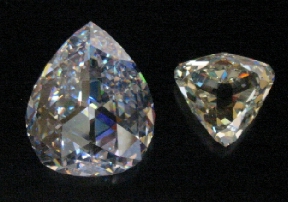
Specifications
Weight: 86 carats
Dimensions: 42 x 35 x 16 mm
Color: Colorless
Weight of Rough: Unknown
Origin: Unknown; probably India
Date Found: Unknown
Current Location: Topkapi Palace and Museum, Istanbul, Turkey; Turkish Crown Jewels
Details
This stone has an uncertain history, but since the early 1800’s has been in possession of the Turkish government. It is currently on display at the Topkapi Palace and Museum in Istanbul.
There is a discrepancy in the historical record concerning the weight of this diamond. It is reported as 86 carats, yet documentation from the early 1800’s state that it is the third largest diamond in the world. This would not be accurate, as the Orlov (189.6 carats), Darya-I-Nur/Great Table (a minimum of 175 carats), Koh-I-Noor (estimated at 186 carats), Florentine (137.27 carats), Nassak (90 carats), and Shah (88.6 carats) would be bigger, making it at least seventh. (All carats used in this paragraph are old carats to avoid confusion with the historical record.)
There is some question concerning the cut of this stone, which affects modeling and hence its weight. When modeled as a double Dutch rose cut, where the top is cut identically to the bottom, a diamond 42x35x16 weighs 153.5 carats as a minimum, or 258.9 carats CZ weight. The CZ replica weighs 270 carats, accurate to fractions of a millimeter in reported dimensions. Therefore, the difference of 11 carats between the calculated CZ weight and actual weight could be due to the variability of the dimensions (+/- 1 mm in reported weight, cut to =/- 0.1 mm).
The stone has been reported as a bizot cut (Balfour, any edition), but he gives no definition of this term, nor is one to be found (if you find one, please email me). It is possible that it means the back is perfectly flat, and only the top is faceted. There is anecdotal evidence that this is possible, as Balfour and others also report that silver foil has been known to be placed on the back to improve brilliance. This is also corroborated by the CZ replica, as this replica is very brilliant with no need to improve it, leading me to believe the back should be flat.
Modeling of the flat back is ongoing, but strongly suggests that any weight discrepancy will actually be more pronounced than if cut as a double Dutch rose cut.
Modeling this stone is somewhat problematic, as the reported dimensions of 42x35x16 have considerable variability, as any dimension could vary ± 0.5 mm. It could be as small as 41.5×34.5×15.5 or as large as 42.5×35.5×16.5. In a stone this large, this variability is as much as 14 carats if cut with a flat back. Additionally, there is no girdle depth mentioned. The difference in weight between a 1.0 mm girdle and 2.0 mm girdle is significant. These inaccuracies make any attempt at accurate modeling very difficult.
Also, the reported stone size makes it a very large diamond. A diamond 42x35x16 with a specific gravity approximately of 3.51 g/cc seems like it MUST weigh more than 86 carats. The 90 carat version of the Nassak measures only 23.35×21.73×11.51. It is hard to believe that the much larger Spoonmaker has a similar weight.

and Nassak (right) reportedly weighs 90 carats.
There is a disconnect somewhere!
What does this mean? The stone weight has been under-reported for over 200 years! Due to the variability in dimensions, girdle depth, and multiple solutions to the modeling problem caused by insufficient information, the actual diamond could weigh as much as 186 carats. Somewhere in the last 200 years, someone may have dropped the leading digit!
This would not be hard to believe if the historical record is correct. The Orlov and Darya-I-Nur/Great Table are certainly bigger. The old version of the Koh-I-Noor (186 carats) is close enough to the possible weight of the Spoonmaker that the latter could be larger by a fraction. Now it is the third largest diamond and agrees with this part of history.
So, what is the real weight of the Spoonmaker? Is the reported weight of 86 carats to be believed? Or has it been misreported, and it is closer to 186 carats? This stone is a part of the Turkish Crown Jewels and is on display at the Topkapi Museum and Palace in Istanbul. Several attempts have been made through the Turkish consulate in Los Angeles, the Turkish Ministry of Culture, and a letter to the museum itself to request contact information of the stone’s curator to resolve this problem. Unfortunately, as of August 2009, none have replied. Efforts are ongoing, and when a definitive answer is known, it will be published here.
